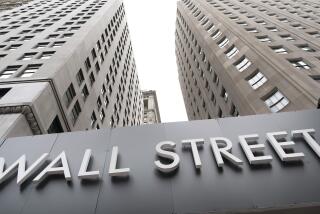Asia Rout Hurls Wall Street Onto Roller-Coaster Ride
- Share via
Renewed fears that the Asian financial crisis could dramatically slash U.S. corporate profits sparked a dramatic roller-coaster ride in stocks Friday, with the Dow Jones industrial average closing 90 points lower after plunging three times that much early in the day.
The sell-off, which came on the second-highest trading volume of all time, culminated a week of sharply increasing worries about corporate earnings and the health of the stock market. At least two influential Wall Street analysts now suggest that a bear market may have already begun.
Surging economies in the U.S. and Asia have fueled several years of double-digit annual profit gains--a major underpinning of what has become the greatest bull market in history. But in the last week, several major companies have warned about Asia-related problems, and Wall Street has suddenly come to the conclusion that the “Asian flu” is a far more serious threat to U.S. profits than was believed even a few weeks ago.
In the last few days, Asian governments have taken several steps to rescue their economies. But U.S. investors now worry that the damage is too severe to be easily reversed.
“[Reform packages] don’t solve the problem that there will be a tremendous slowdown in growth throughout all of Asia and it’ll be long-lived,” said Charles Pradilla, a stock market strategist at Cowen & Co. in New York. “It’ll affect not just a quarter for these multinationals; it’ll affect long-term growth rates.”
After yet another sharp drop in Asian stocks overnight, the Dow fell 269 points in the first hour and 45 minutes of trading Friday. But the blue-chip index recovered two-thirds of its loss through the day as investors sensed a buying opportunity and swooped in to pick up shares at lower prices.
The Dow closed at 7756.29, off 90.21 points, or 1.15%. More than 782 million shares changed hands, the most since Oct. 28, the day the market rebounded from its 554-point “Gray Monday” plunge.
In one of the few positive signs, technology stocks, which have been battered the last few weeks, rallied back from early selling to end up for the day.
Ever since the Asian situation led to the “Gray Monday” decline, investors have fretted that profits would suffer because of reduced Asian demand for U.S. goods.
The market began a three-week recovery from the sell-off in mid-November, when investors thought the worst of the Asian problem had passed.
But the optimism turned around the last two weeks as U.S. companies began reporting weaker earnings due to Asian woes.
Moves by Japan, which unveiled an economic-stimulus package that included a tax cut, and by Korea, whose newly elected president pledged to stick to a tough fiscal austerity plan, have done little to soothe the U.S. market.
“The Asian thing represents a real change that will dog us for a year or more,” said Marshall Acuff, portfolio strategist at Salomon Smith Barney in New York.
Asia poses several problems for U.S. companies. First, weakened Pacific Rim countries will buy fewer U.S. products. Second, a wave of currency devaluations throughout the region means Asian exports are suddenly cheaper in the U.S. That keeps U.S. companies from raising prices and means they might have to lower them. That’s especially dangerous because wages have been on the rise lately, further squeezing profit margins.
Wall Street was jolted Wednesday when Minnesota Mining & Manufacturing Co. warned of lower profits because of flagging sales in both the U.S. and abroad. 3M, the maker of Post-It notes and other consumer products, shook up investors because it revealed weakness across its global operations.
Also Wednesday, athletic-gear giant Nike Inc. said profits would be weak, in large part because of trouble in Asia. The two red flags followed by a little more than a week a surprise profit warning from technology giant Oracle Corp.
*
Indeed, there is little doubt that Asia will crimp profits. Five weeks ago, Wall Street analysts expected aggregate profits for the companies whose stocks are listed in the Standard & Poor’s 500 index to rise 11.2% in the fourth quarter, according to First Call Corp., a Boston firm that tracks the numbers. That projection has been cut to 8.3% today and may tumble lower.
Analysts have barely trimmed their 1998 earnings estimates, believing that profits will jump 14.1% next year. But many on Wall Street say it’s only a matter of time before 1998 estimates come down as well.
“To go from 8% in the fourth quarter to 14% next year is asking a lot,” said Chuck Hill, First Call research director.
The profit worries have some well-known Wall Street experts saying a bear market is already underway. On Thursday, widely followed analysts Barton Biggs of Morgan Stanley Dean Witter and Ralph Acampora of Prudential Securities issued markedly downbeat assessments. Acampora’s was especially noteworthy because he had been one of Wall Street’s raging bulls. He now says a bear market has started and the Dow could plummet to 6,000 by late next year.
But many others on Wall Street believe that the U.S. will weather the storm. While the stock market is clearly facing its stiffest challenge in at least three years, U.S. growth is solid, and a potential pickup in Europe could partially offset Asia, they say.
“We’re not in a bear market because a lot of domestic U.S. corporations are still very healthy and there’s low inflation and the bond market is very strong,” Pradilla said.
Indeed, the yield on the 30-year Treasury bond continued to drop on Friday. It finished at 5.92%, down from 5.93% a day earlier. Lower bond yields, which have come down amid signs that the economy is slowing and the Federal Reserve won’t raise interest rates, cut companies’ borrowing costs and improve the outlook for their earnings.
“I’d be hesitant to say we’re going to stop growing and profits will collapse,” Acuff said.
The rebound from Friday’s lows was spurred by announcements from General Electric Co. and Chevron Corp. that they will buy back billions of dollars worth of their own stock. Such news is taken as a sign by investors that a company considers its shares to be undervalued and a good bargain.
Stocks have been hit hard in part because the U.S. market was considered to be overvalued by many analysts after an almost uninterrupted advance since late 1994. For the week, the Dow shed 82 points and is about 500 points shy of its all-time closing high. Nevertheless, it’s still up 20.3% for the year to date.
More to Read
Inside the business of entertainment
The Wide Shot brings you news, analysis and insights on everything from streaming wars to production — and what it all means for the future.
You may occasionally receive promotional content from the Los Angeles Times.









